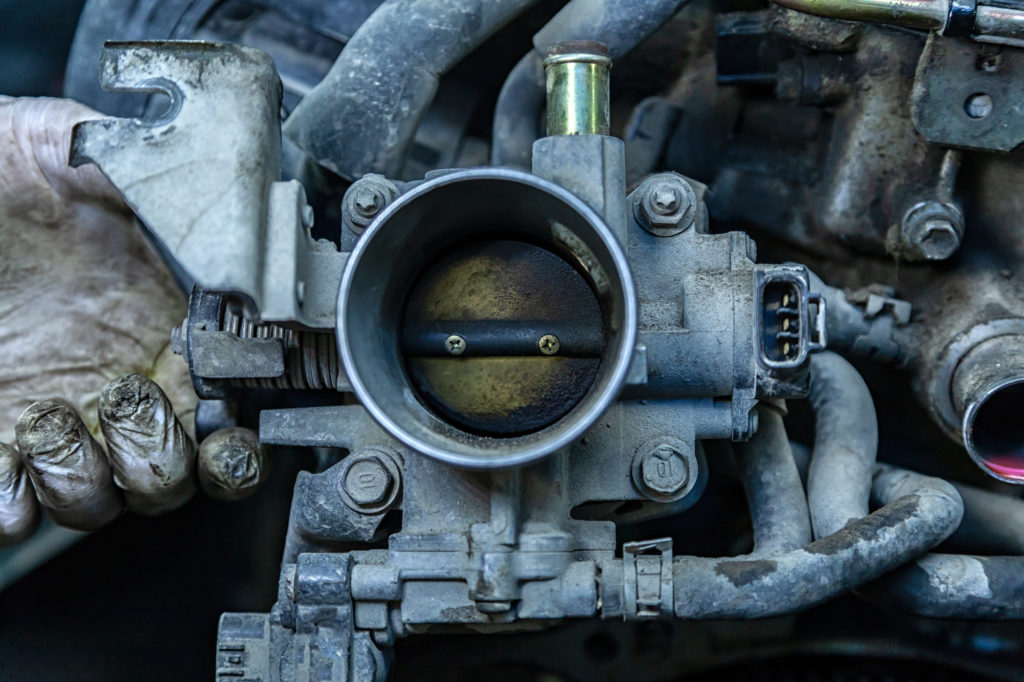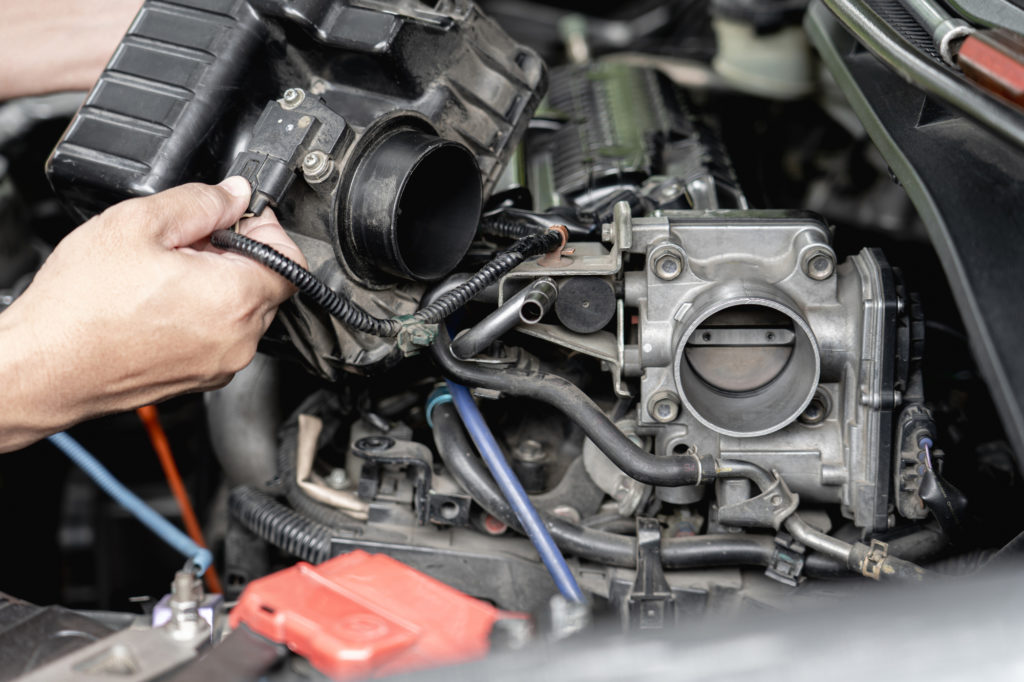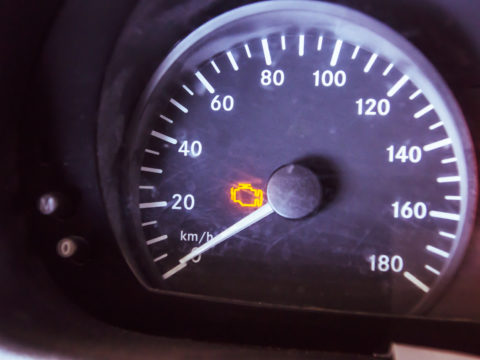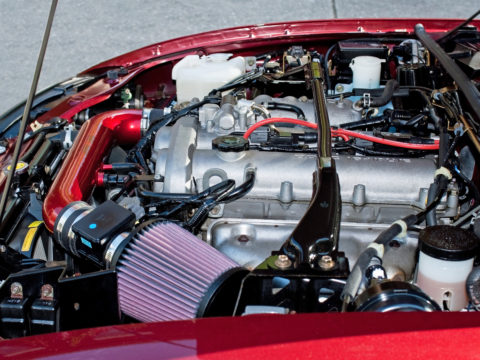The throttle body is a critical engine component that plays a vital role in the running condition of your vehicle. Understanding how throttle bodies work and why they fail is crucial for maintaining your car in peak condition.

Keep reading to explore common symptoms of a bad throttle body, the reasons throttle bodies fail, what to expect when replacing this part, and more.
Contents
What Does a Throttle Body Do?
A car’s throttle body controls the engine’s air intake.It is a cylindrical-shaped housing that rotates to allow varying amounts of air to enter the engine. Most cars only have one throttle body. But, a larger engine may have one for every cylinder bank (or even one per cylinder).
Throttle Body Diagram
When a driver depresses the gas pedal, the throttle plate opens, and the throttle body allows air to enter the engine. When the driver takes their foot off the gas, it closes again.
Where Is the Throttle Body Located?
The throttle body lies between the air filter and intake manifold inside most cars.In older cars, it is part of the carburetor. Most cars have the throttle body connected to the gas pedal through a cable or wire that moves the throttle shaft when the driver presses the gas pedal.
Sometimes, they are attached to the air-intake tubes via fasteners, like Torx-head screws, which may require specific screwdrivers or bits to remove or alter. But, usually, standard flat or Phillips-head screwdrivers should work.
Symptoms of a Bad Throttle Body
Your car may experience the following symptoms if the throttle body is malfunctioning:
Lack of Power While Driving or Accelerating
One of the most common symptoms of a bad throttle body is a lack of power while driving and/or accelerating. If you feel your car is not accelerating as smoothly as it should, the throttle body may be responsible.
The same can apply if there is no power surge when depressing the gas pedal. A lack of air entering the engine through the throttle body is at the root of this issue and may mean you need to have it replaced or well cleaned.
Unusual Idling
Higher and lower idling speeds are another common symptom of a failing throttle body. If your car stalls after coming to a stop or idles at a low level, there may be dirt built up in your throttle body, or it may be failing for another reason.
Electrical Issues
If your car is experiencing electrical issues, the throttle body might be bad. Reduced power modes, like limp mode, might be activated by a dirty or malfunctioning throttle body. The electronic sensor, which is responsible for making successful corrections to the amount of air entering the throttle body, could be broken or covered in dirt.
Poor Gas Mileage
Poor gas mileage is another symptom of a faulty throttle body. Since the throttle body is responsible for your engine’s performance, it can negatively impact your car’s fuel economy. Significant declines in the distance you can drive on one tank of gas may indicate that the throttle body is failing.
The easiest way to keep an eye on your car’s fuel economy is by noting how many miles you have before and after filling up on gas. If you’re experiencing a significant decline, around 15%, you may be experiencing a throttle body failure.
Check Engine Light
As a crucial part of your engine, the throttle body will signal the car’s computer if it is failing or if there is another issue with its performance. If the check engine light is on, you may have an issue with your car’s throttle body, especially if you are experiencing any of the other symptoms discussed above.
If the check engine light is on and you suspect that the throttle body is to blame, you can perform a manual check to confirm it is the issue or rule it out.

What Causes a Car Throttle Body To Fail?
There are a few reasons why a car’s throttle body fails. You can explore the most common below.
Dirt Build-up
If your throttle body is dirty or some amount of grime has built up, it may not function. As more and more dirt fills the throttle body, its performance will decline significantly. When an uneven coating of grime disrupts the airflow, your car’s engine may suffer.
Stuck Butterfly Valve
If it has been a long time since you cleaned the throttle body, the butterfly valve may be stuck. The butterfly valve is the throttle body component that opens and closes, allowing the right amount of air to enter. If it’s stuck closed, your engine may be getting too little air to run efficiently.
Vacuum Leaks
Vacuum leaks are another reason that the throttle body might fail. If you have a vacuum leak, excessive air is flooding the system and will result in an incorrect air-fuel mixture.
Throttle Body Mechanism Failure
A failure of the throttle body mechanism is another reason you may be having issues with this component. Physical damage or everyday wear and tear use may break the mechanism. A breakage can occur with both mechanical and electric throttle bodies.
Will a Car Run With a Bad Throttle Body?
The car will usually run with a bad throttle body, but it is not safe to drive. The vehicle could stall unexpectedly in traffic or fail to accelerate when it needs to, creating a serious safety hazard.
Does Cleaning the Throttle Body Make a Difference?
Yes, cleaning the throttle body makes a difference in how well your car runs. If dirt and grime build up, it is more likely that the component will be unable to let in the right amount of air, and your engine may not function correctly. You should clean your throttle body because it is a necessary engine component for car performance and safety.
What To Do After Replacing the Throttle Body?
After replacing a throttle body, you need to reprogram it. Some vehicles do this automatically, while others require manual reprogramming. After the new component is in the car, the vehicle should be allowed to idle for a few minutes, and then it should be taken out and driven for a few miles at different speeds.
Throttle Body Replacement Cost
Depending on the car, the throttle body will cost between $250 and $650 to replace, including labor costs. The piece itself is usually between $200 and $500.














